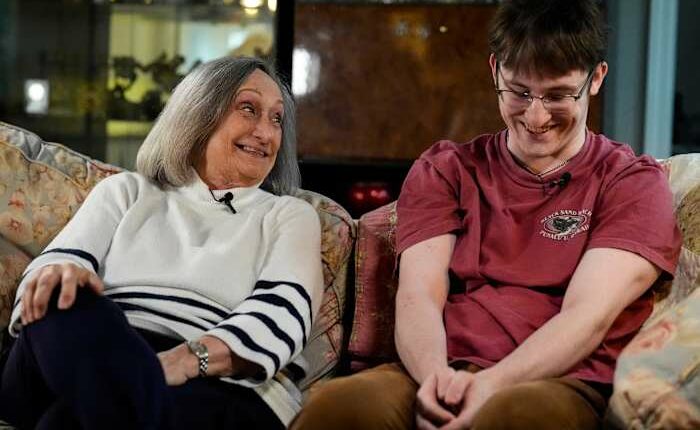Share this @internewscast.com

The year 2026 marks a significant milestone as the oldest members of the baby boomer generation—those who once spearheaded a cultural and political shift across the United States—turn 80 years old.
This influential generation, known for introducing the world to hula hoops and Barbie dolls, embracing the television era, soaking in the vibes of Woodstock, and standing against the Vietnam War, is now a driving force behind America’s aging demographic. The very cohort that coined the phrase “don’t trust anyone over 30” now finds itself in a different phase of life.
Among those entering their eighth decade are iconic figures such as actor Henry Winkler, baseball legend Reggie Jackson, music stars Cher and Dolly Parton, and former presidents Donald Trump, George W. Bush, and Bill Clinton.
The demographic shift in America is becoming increasingly evident as the population’s youth dwindles and the elderly numbers swell.
The baby boom, a period from 1946 to 1964, saw approximately 76 million births, fueled by reunions of couples after World War II and a wave of postwar prosperity.
As they matured, boomers enjoyed greater educational opportunities and financial success compared to previous generations, fostering a consumer-driven economy. In their formative years, they played pivotal roles in advocating for social change, championing movements for civil rights, women’s rights, and an end to the Vietnam War.
“We had rock ‘n’ roll. We were the first generation to get out and demonstrate in the streets. We were the first generation, that was, you know, a socially conscious generation,” said Diane West, a metro Atlanta resident who turns 80 in January. “Our parents played by the rules. We didn’t necessarily play by the rules, and there were lots of us.”
As they got older they became known as the “me” generation, a pejorative term coined by writer Tom Wolfe to reflect what some regarded as their self-absorption and consumerism.
“The thing about baby boomers is they’ve always had a spotlight on them, no matter what age they were,” Brookings demographer William Frey said. “They were a big generation, but they also did important things.”
By the end of this decade, all baby boomers will be 65 and older, and the number of people 80 and over will double in 20 years, Frey said.
The share of senior citizens in the U.S. population is projected to grow from 18.7% in 2025 to nearly 23% by 2050, while children under 18 decline from almost 21% to a projected 18.4%.
Without any immigration, the U.S. population will start shrinking in five years. That’s when deaths will surpass births, according to projections from the Congressional Budget Office, which were revised in September to account for the Trump administration’s immigration crackdown. Population growth comes from immigration as well as births outpacing deaths.
The aging of America is being compounded by longer lives due to better health care and lower birth rates.
The projected average U.S. life expectancy at birth rises from 78.9 years in 2025 to 82.2 years in 2055, according to the CBO. And since the Great Recession in 2008, when the fertility rate was 2.08, around the 2.1 rate needed for children to numerically replace their parents, it has been on a steady decline, hitting 1.6 in 2025.
Younger generations miss boomer milestones
Women are having fewer children because they are better educated, they’re delaying marriage to focus on careers and they’re having their first child at a later age. Unaffordable housing, poor access to child care and the growing expenses of child-rearing also add up to fewer kids.
University of New Hampshire senior demographer Kenneth Johnson estimates that the result has been 11.8 million fewer births, compared to what might have been had the fertility rate stayed at Great Recession levels.
“I was young when I had kids. I mean that’s what we did — we got out of college, we got married and we had babies,” said West, who has two daughters, a stepdaughter and six grandchildren. “My kids got married in their 30s, so it’s very different.”
A recent Census Bureau study showed that 21st century young adults in the U.S. haven’t been adulting like baby boomers did. In 1975, almost half of 25-to-34-year-olds had moved out of their parents’ home, landed jobs, gotten married and had kids. By the early 2020s, less than a quarter of U.S. adults had hit these milestones.
West, whose 21-year-old grandson lives with her, understands why: They lack the prospects her generation enjoyed. Her grandson, Paul Quirk, said it comes down to financial instability.
“They were able to buy a lot of things, a lot cheaper,” Quirk said.
All of her grandchildren are frustrated by the economy, West added.
“You have to get three roommates in order to afford a place,” she said. “When we got out of college, we had a job waiting for us. And now, people who have master’s degrees are going to work fast food while they look for a real job.”
Implications for the economy
The aging of America could constrain economic growth. With fewer workers paying taxes, Social Security and Medicare will be under more pressure. About 34 seniors have been supported by every 100 workers in 2025, but that ratio grows to 50 seniors per 100 working-age people in about 30 years, according to estimates released last year by the White House.
When West launched her career in employee benefits and retirement planning in 1973, each 100 workers supported 20 or fewer retirees, by some calculations.
Vice President JD Vance and Tesla CEO Elon Musk are among those pushing for an increase in fertility. Vance has suggested giving parents more voting power, according to their numbers of children, or following the example of Hungary’s Viktor Orbán in giving low-interest loans to married parents and tax exemptions to women who have four children or more.
Frey said programs that incentivize fertility among U.S. women hardly ever work, so funding should support pre-kindergarten and paid family leave.
“I think the best you can do for people who do want to have kids is to make it easier and less expensive to have them and raise them,” he said. “Those things may not bring up the fertility rate as much as people would like, but at least the kids who are being born will have a better chance of succeeding.”
__
Emilie Megnien in Atlanta contributed to this report.
__
Follow Mike Schneider on the social platform Bluesky: @mikeysid.bsky.social
Copyright 2025 The Associated Press. All rights reserved. This material may not be published, broadcast, rewritten or redistributed without permission.










